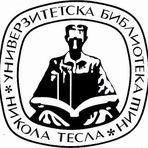Title
Nova konstrukcija i matematički model pijezoelektričnog dinamičkog apsorbera za kontrolu vibracija mostovskih konstrukcija
Creator
Paunović, Stepa 1989-
CONOR:
94931977
Copyright date
2023
Object Links
Select license
Autorstvo-Nekomercijalno-Bez prerade 3.0 Srbija (CC BY-NC-ND 3.0)
License description
Dozvoljavate samo preuzimanje i distribuciju dela, ako/dok se pravilno naznačava ime autora, bez ikakvih promena dela i bez prava komercijalnog korišćenja dela. Ova licenca je najstroža CC licenca. Osnovni opis Licence: http://creativecommons.org/licenses/by-nc-nd/3.0/rs/deed.sr_LATN. Sadržaj ugovora u celini: http://creativecommons.org/licenses/by-nc-nd/3.0/rs/legalcode.sr-Latn
Language
Serbian
Cobiss-ID
Theses Type
Doktorska disertacija
description
Datum odbrane: 19.04.2024.
Other responsibilities
Academic Expertise
Tehničko-tehnološke nauke
University
Univerzitet u Nišu
Faculty
Građevinsko-arhitektonski fakultet
Group
Katedra za tehničku mehaniku i teoriju konstrukcija
Alternative title
A novel construction and mathematical model of piezоеlectric dynamic absorber for vibration control of bridges
Publisher
[S. M. Paunović]
Format
156 listova
description
Bibliografija: list 139-155.
Biografija autora: list 156.
description
Engineering mechanics and theory of structures
Abstract (en)
In the dissertation a novel construction of a dynamic absorber for bridge
vibration control is presented, with piezoelectric elements, in a form of
connected bimorph beams, added to the absorbers. Through adding the
piezo-elements, part of the mechanical energy of bridge vibrations is
transformed into electrical energy, turning the piezoelecric dynamic
absorber (PEDA) into an energy harvesting device. Generated electric
energy is able to power bridge monitoring devices and signalisation. A
thourough mathematical model of PEDA is devised and then validated by
comparing the results to the ones in the literature. The model also allows
for improvement of the PEDA performance by the use of materials
modelled with derivatives of non-integer order. The governing equations
are derived through the Hamilton’s principle, and then solved via the
Galerkin spatial discretization and Newmark numerical integration
procedure in the time domain, and by assuming the quasi-stationary
vibration state for the solution in the frequency domain. In the
dissertation, the procedure is also presented for optimizing geometrical
and material paramerters of the PEDA model, as well as optimizing the
number and dispositoin of the absorbers on the bridge, with the goal to
minimize bridge vibrations and maximize generated electrical power. An
example of application of PEDA for bridge vibration control is also
provided, and several possible ways for further improving the PEDA
performance are included. The results show that bridge dynamic
characteristics can be significantly improved through the use of PEDA,
while at the same time generating a meaningful amount of electrical
energy for a wide range of forcing load frequencies, making PEDA a
potentially valiable asset in achieving sustainable development
Authors Key words
dinamički apsorberi, kontrola vibracija, pijezoelektrični
elementi, sakupljači energije, frakcioni račun, hibridni sistemi
Authors Key words
dynamic absorbers, vibration control, piezoelectric devices, energy harvesting, fractional calculus, hybrid systems
Classification
624.21:621.8.034(043.3)
Subject
Т 220
Type
Tekst
Abstract (en)
In the dissertation a novel construction of a dynamic absorber for bridge
vibration control is presented, with piezoelectric elements, in a form of
connected bimorph beams, added to the absorbers. Through adding the
piezo-elements, part of the mechanical energy of bridge vibrations is
transformed into electrical energy, turning the piezoelecric dynamic
absorber (PEDA) into an energy harvesting device. Generated electric
energy is able to power bridge monitoring devices and signalisation. A
thourough mathematical model of PEDA is devised and then validated by
comparing the results to the ones in the literature. The model also allows
for improvement of the PEDA performance by the use of materials
modelled with derivatives of non-integer order. The governing equations
are derived through the Hamilton’s principle, and then solved via the
Galerkin spatial discretization and Newmark numerical integration
procedure in the time domain, and by assuming the quasi-stationary
vibration state for the solution in the frequency domain. In the
dissertation, the procedure is also presented for optimizing geometrical
and material paramerters of the PEDA model, as well as optimizing the
number and dispositoin of the absorbers on the bridge, with the goal to
minimize bridge vibrations and maximize generated electrical power. An
example of application of PEDA for bridge vibration control is also
provided, and several possible ways for further improving the PEDA
performance are included. The results show that bridge dynamic
characteristics can be significantly improved through the use of PEDA,
while at the same time generating a meaningful amount of electrical
energy for a wide range of forcing load frequencies, making PEDA a
potentially valiable asset in achieving sustainable development
“Data exchange” service offers individual users metadata transfer in several different formats. Citation formats are offered for transfers in texts as for the transfer into internet pages. Citation formats include permanent links that guarantee access to cited sources. For use are commonly structured metadata schemes : Dublin Core xml and ETUB-MS xml, local adaptation of international ETD-MS scheme intended for use in academic documents.


